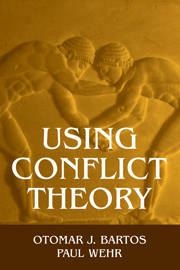Book contents
- Frontmatter
- Contents
- List of Figures and Tables
- Acknowledgments
- 1 Introduction
- 2 Understanding Conflict
- 3 Development of Incompatible Goals
- 4 Application to the Civil Rights Struggle
- 5 Emergence of Overt Conflicts
- 6 Application to a University Conflict
- 7 Escalation and Deescalation
- 8 Application to Conflict in Bosnia
- 9 Making Conflict Work Economically
- 10 Understanding and Managing Conflicts
- Appendix: Prelude to the Dissolution of Yugoslavia
- Notes
- References
- Index
4 - Application to the Civil Rights Struggle
Published online by Cambridge University Press: 05 June 2012
- Frontmatter
- Contents
- List of Figures and Tables
- Acknowledgments
- 1 Introduction
- 2 Understanding Conflict
- 3 Development of Incompatible Goals
- 4 Application to the Civil Rights Struggle
- 5 Emergence of Overt Conflicts
- 6 Application to a University Conflict
- 7 Escalation and Deescalation
- 8 Application to Conflict in Bosnia
- 9 Making Conflict Work Economically
- 10 Understanding and Managing Conflicts
- Appendix: Prelude to the Dissolution of Yugoslavia
- Notes
- References
- Index
Summary
even when one has a general understanding of why conflicts occur, one may wish to know why a specific conflict has occurred. This chapter addresses that concern by applying the theory of the preceding chapter to the civil rights struggle in the United States.
The African American Struggle for Equality
The most common type of internal conflict develops out of unjust inequality. It is often manifested as the domination of one economic, cultural, or racial group by another. Such dominance produces the potential for conflict of such magnitude that it literally tears a society apart.
Most Americans would agree that the struggle between African Americans and American whites has been largely due to the unfair treatment of blacks, first as slaves, then as second- or third-class citizens. The blacks' goal of equality has been incompatible with the goal of continued dominance by whites. As obvious as that explanation might seem in the light of history, in this book we take nothing for granted, not even a universally held belief. We shall use our theory and known facts to determine whether this belief is correct. Most of the facts of the case can be summarized in a brief history of that struggle.
Before the Civil War, most African Americans were held in slavery. In the South their legal enslavement was soon thereafter replaced by Jim Crow segregation, from which they then struggled to escape for nearly a century.
- Type
- Chapter
- Information
- Using Conflict Theory , pp. 50 - 69Publisher: Cambridge University PressPrint publication year: 2002



